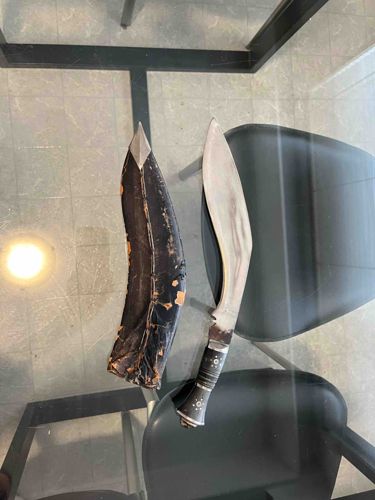
Kukri Knife with Scabbard
This item is a traditional Kukri knife, characterized by its distinctive inwardly curved blade. The blade itself appears to be made of polished metal, likely steel, showing some variations in surface texture which might indicate hand-forging or age-related patina and light scratching. The primary cutting edge is on the concave side of the blade, which thickens towards the spine. There's a noticeable 'cho' or 'kaudi' notch at the base of the blade near the handle, a common feature in Kukris thought to be a blood drain or a device to catch an opposing blade. The handle is segmented, featuring what appears to be black horn or a similar dark material with decorative white or silver-colored dot inlays, possibly bone, metal, or painted accents, arranged in geometric patterns. The craftsmanship on the handle seems intricate, suggesting attention to detail in its construction. The pommel end of the handle features a flared shape. Accompanying the Kukri is its scabbard (sheath), which is made of a dark material, likely leather, though it appears heavily worn and distressed. The scabbard shows significant flaking and loss of its outer layer, revealing a lighter material underneath, indicating considerable age and use, or poor storage conditions. The tip of the scabbard has a distinctive metal chape, which is somewhat pointed, suggesting protection against wear. The overall condition of the Kukri blade seems fair, with some surface wear visible, while the scabbard is in visibly poor condition due to material degradation. The style and construction suggest it could be a vintage or antique piece, possibly from the early to mid-20th century, given the visible wear and traditional design.
AI-Generated Appraisal Disclaimer
Estimated Value
$150-250
Basic Information
Category
Bladed Weapon/Tool
Appraised On
December 1, 2025
Estimated Value
$150-250
Item Description
This item is a traditional Kukri knife, characterized by its distinctive inwardly curved blade. The blade itself appears to be made of polished metal, likely steel, showing some variations in surface texture which might indicate hand-forging or age-related patina and light scratching. The primary cutting edge is on the concave side of the blade, which thickens towards the spine. There's a noticeable 'cho' or 'kaudi' notch at the base of the blade near the handle, a common feature in Kukris thought to be a blood drain or a device to catch an opposing blade. The handle is segmented, featuring what appears to be black horn or a similar dark material with decorative white or silver-colored dot inlays, possibly bone, metal, or painted accents, arranged in geometric patterns. The craftsmanship on the handle seems intricate, suggesting attention to detail in its construction. The pommel end of the handle features a flared shape. Accompanying the Kukri is its scabbard (sheath), which is made of a dark material, likely leather, though it appears heavily worn and distressed. The scabbard shows significant flaking and loss of its outer layer, revealing a lighter material underneath, indicating considerable age and use, or poor storage conditions. The tip of the scabbard has a distinctive metal chape, which is somewhat pointed, suggesting protection against wear. The overall condition of the Kukri blade seems fair, with some surface wear visible, while the scabbard is in visibly poor condition due to material degradation. The style and construction suggest it could be a vintage or antique piece, possibly from the early to mid-20th century, given the visible wear and traditional design.
Related Tags
Explore similar items and categories:
Get Your Items Appraised
Instant estimates of your treasures with AI-powered instant appraisals